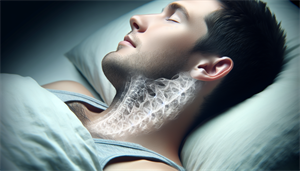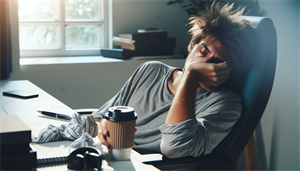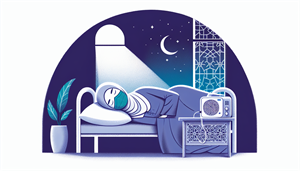Obstructive Sleep Apnea (OSA) is a serious sleep disorder where breathing repeatedly stops and starts during sleep due to collapsed airways. These interruptions affect sleep quality and can contribute to long-term health complications.
In this article, we will discuss “what is obstructive sleep apnea” by outlining the symptoms, risk factors, and treatment options for OSA, equipping you with vital information to understand and address this condition.
Key Takeaways
-
Obstructive Sleep Apnea (OSA) is a common disorder characterized by repeated interruptions of breathing during sleep due to partial or complete collapse of the airway, affecting approximately 1 billion adults globally and up to 90% of those with the condition remain unaware of it.
-
Risk factors for OSA include anatomical issues such as micrognathia, adenoid hypertrophy, obesity, lifestyle choices like smoking and alcohol use, as well as inherited physical traits, while the severity is measured by the apnea-hypopnea index (AHI).
-
Managing OSA involves several strategies such as medical treatments including Continuous Positive Airway Pressure (CPAP) and surgical interventions, as well as lifestyle changes like weight management and optimizing the sleep environment; untreated OSA can result in severe cardiovascular, cerebrovascular, and mental health complications.
Unveiling Obstructive Sleep Apnea (OSA)

To demystify Obstructive Sleep Apnea (OSA), one must first comprehend its nature. OSA is a common sleep disorder that involves repeated interruptions in breathing during sleep, caused by a full or partial collapse of the upper airway.
Obstructive sleep apnea occurs when the obstruction of the upper airway can be due to a negative collapsing pressure during inspiration. This can be worsened by the progressive narrowing during expiration in the retro palatal area. OSA has significant implications for cardiovascular health, mental well-being, and quality of life. It also affects driving safety, making it more than just a nighttime nuisance.
Distinguishing OSA from other sleep disorders is crucial as it is often mistaken for central sleep apnea, a different type of sleep apnea which occurs when the brain fails to send proper signals to the muscles that control breathing, rather than an obstruction in the airway. Knowing the difference is key, as while both disorders disrupt sleep, the causes and treatments vary.
Defining the Sleep Disorder
OSA occurs when throat muscles relax during sleep, narrowing or blocking the airway, which results in disrupted breathing and sleep disruption. The relaxation of these throat muscles can result in the narrowing or complete blockage of the airway, leading to the interruption of normal breathing and the onset of OSA. It’s like trying to drink a thick milkshake through a narrow straw; you might get some through, but it’s a struggle.
Interestingly, anatomical and neuromuscular factors contribute to the airway obstruction observed in OSA, which makes it a complex disorder to manage. The result is a series of complete or partial airway collapses during sleep, leading to reduced or halted airflow, resulting in lowered oxygen levels and disturbed sleep patterns. This struggle for air while you’re sleeping can lead to daytime symptoms such as excessive daytime sleepiness, morning headaches, and dry mouth upon waking.
Frequency and Severity
Far from a solitary condition, OSA impacts nearly 1 billion adults aged 30–69 years globally. (source)
In the United States alone, about 2% of children and an estimated 25-30% of men and 9-17% of women meet the criteria for OSA. However, what’s alarming is that up to 90% of individuals with OSA are unaware of their condition. That’s like walking around with a ticking time bomb and not knowing it!
The severity of OSA is measured using the apnea-hypopnea index (AHI), which is the combined average number of apneas (complete cessations of airflow) and hypopneas (partial reductions of airflow) that occur per hour of sleep. It’s like a scorecard for your sleep, the higher the score, the worse the sleep quality.
The Underlying Causes of OSA
Having understood what OSA is, we can now explore the factors that lead to its emergence. OSA doesn’t discriminate; it can affect anyone, regardless of age or gender. However, certain anatomical and lifestyle factors can increase the risk.
Anatomical factors such as micrognathia (a condition where the jaw is undersized), adenoid and tonsillar hypertrophy (enlargement), and inferior displacement of the hyoid (a bone in the neck) can contribute to OSA. On the other hand, factors such as lifestyle choices, like excess body weight and genetic factors like obesity and certain inherited physical traits, can significantly elevate the risk of developing OSA. It’s like a jigsaw puzzle, where each piece contributes to the complete picture of OSA.
Anatomical Factors
Obesity, a common factor among individuals with OSA, significantly increases the risk of developing the condition. It’s like trying to squeeze into a pair of jeans that are too tight; the excess weight is putting pressure on your airway, making it harder for air to flow freely.
Moreover, having a family history of OSA could also increase your risk of developing the sleep disorder. This is due to the genetic aspect of OSA, which involves several interacting genetic and environmental factors. It’s like inheriting your mother’s eye color or your father’s sense of humor.
In the same vein, enlarged tonsils and adenoids can also increase the risk of OSA, as they can obstruct the throat, leading to a blockage that causes the condition.
Lifestyle and Health Conditions
Similarly to how smoking damages your lungs, it also negatively impacts your sleep health. There is a greater occurrence of smoking among individuals with OSA, and smoking may be linked to OSA and impact the quality of sleep. Similarly, alcohol consumption is associated with an elevated risk and deterioration of OSA. It’s like adding fuel to the fire; the alcohol relaxes the muscles in your throat, making the obstruction worse.
On the other hand, chronic nasal congestion, such as that resulting from sinusitis, can lead to OSA due to the sinus congestion and inflammation that obstruct the nasal passages. It’s like trying to breathe through a narrow straw; the more congested your nasal passage is, the harder it is for air to flow.
Recognizing the Symptoms of OSA

Comprehending OSA’s symptoms is vital to identify the condition and pursue effective treatment. Symptoms of OSA can manifest during sleep and throughout the day, affecting overall well-being.
Adults with OSA often exhibit indicators such as loud snoring, gasping or choking during sleep, morning headaches, excessive daytime sleepiness, irritability, depression, and memory problems. On the other hand, children with OSA might exhibit symptoms such as snoring, mouth breathing, bed-wetting, sleep terrors, and behavioral issues such as difficulty paying attention and aggressive behavior. Yes, OSA can affect children too; it does not discriminate by age.
Nighttime Indicators
Nighttime is when OSA rears its ugly head the most. Typical nighttime symptoms include:
-
Loud snoring
-
Gasping
-
Choking
-
Breathing cessation during sleep
Your partner might be the first to notice these signs, especially if your snoring could shake the house or you stop breathing during your sleep.
The nature of snoring in patients with OSA is loud and disruptive, often accompanied by excessive daytime sleepiness. It’s not your regular snoring; it’s like a freight train running through your bedroom. Furthermore, the gasping and choking during sleep in individuals with OSA are attributed to temporary blockages resulting in upper airway obstruction that occurs intermittently during the night. It’s like trying to breathe through a narrow straw; every breath is a struggle.
Daytime Consequences
The effects of OSA don’t just disappear when the sun rises. Daytime symptoms such as:
-
excessive sleepiness
-
morning headaches
-
irritability
-
memory problems
can be a big red flag. It’s like walking around in a fog; even though you’re awake, you’re not really alert.
Morning headaches occur due to the low oxygen levels in the blood resulting from interrupted breathing during sleep, leading to hypoxemia and subsequent headaches upon waking. Furthermore, OSA can affect daytime cognitive functions by leading to challenges with concentration, organization, and planning, which are indicative of mild cognitive impairment associated with the condition.
Also, the insufficient restorative sleep during the night often results in pronounced daytime drowsiness and fatigue, leading to irritability.
Diagnosing Obstructive Sleep Apnea
Identifying OSA’s symptoms is only the starting point. The subsequent step involves obtaining a formal diagnosis. A diagnosis not only confirms the presence of the disorder but also identifies its severity, which is crucial for determining the most effective treatment strategy.
The OSA diagnosis process initiates with an initial consultation with a healthcare expert. During this consultation, the healthcare professional will assess the individual’s symptoms and risk factors to determine the likelihood of OSA. It’s like detective work; the clues are all there, but it takes a skilled professional to put the pieces together and arrive at a diagnosis.
Initial Consultation
The initial consultation is the first step towards a diagnosis. During this consultation, the healthcare professional will review the individual’s medical history, conduct a physical examination, and assess the individual’s symptoms and risk factors for OSA.
Having a family history of OSA could be a potential risk factor for the sleep disorder. Therefore, the medical history plays a crucial role in identifying potential risk factors and symptoms of OSA. Also, a physical exam is conducted to assess for:
-
obesity
-
physical characteristics that elevate the risk of OSA
-
an individual’s neck and waist measurements
-
indications of health issues linked to OSA.
If you’ve ever felt like your doctor was asking too many questions or being too thorough, now you know why; it’s all in the name of getting to the root of the problem.
Diagnostic Procedures
Following the initial consultation, the next phase involves diagnostic procedures. Sleep studies, such as polysomnography and home sleep apnea testing, are employed to confirm the diagnosis of OSA and get obstructive sleep apnea diagnosed.
Polysomnography, also known as a sleep study, is a thorough examination that monitors:
-
Brain waves
-
Blood oxygen levels
-
Heart rate
-
Breathing
-
Movements of the eyes and legs during the assessment
It’s like a surveillance system for your sleep, tracking every breath and movement.
Individuals with a high probability of moderate to severe sleep apnea, or even mild sleep apnea, may find home sleep apnea testing to be appropriate. This option could be considered in such cases. It’s like bringing the sleep lab to your home. However, the presence of a qualified medical professional is crucial during home sleep apnea testing to ensure accurate placement of sensors and precise interpretation of test results.
Treatment Pathways for OSA

Treatment follows after diagnosis. There are various treatment options available for obstructive sleep apnea treated, including non-invasive therapies such as Continuous Positive Airway Pressure (CPAP) machine and mask use, as well as surgical interventions.
The treatments for OSA are formulated with the aim of addressing nighttime breathing disturbances, enhancing sleep quality, and mitigating health complications. It’s like fighting a battle on multiple fronts; you’re not just treating the symptoms but also improving overall health and wellness.
Non-Invasive Therapies
Positive airway pressure (PAP) therapy is the primary non-invasive treatment for OSA. It helps keep the airway open during sleep, improving breathing and reducing symptoms. PAP therapy entails the utilization of a machine that administers pressurized air through a mask to maintain airway openness during sleep, with CPAP being the most prevalent and efficacious form.
The various forms of PAP therapy comprise continuous positive airway pressure (CPAP), bilevel positive airway pressure (BPAP) providing different levels of pressure for inhalation and exhalation, and auto-titrating positive airway pressure (APAP) that adjusts pressure automatically during the night. PAP therapy has been shown to significantly decrease the frequency of breathing interruptions during sleep, reduce daytime sleepiness, and generally enhance the quality of life for individuals with OSA.
Surgical Interventions
When non-invasive therapies aren’t effective or appropriate, surgical interventions may be considered. Options may include upper airway stimulation and tracheostomy.
Surgical interventions encompass:
-
Repair of facial structural defects
-
Removal of excess tissues obstructing airways
-
Correction of abnormalities causing breathing obstructions
-
Widening of the airway
-
Removal of adenoids and tonsils
One of the surgical interventions, upper airway stimulation, is a medical procedure designed for individuals experiencing moderate to severe obstructive sleep apnea and are unable to tolerate CPAP or BPAP.
Managing OSA: Lifestyle Changes and Home Remedies
In addition to medical treatment, lifestyle modifications and home remedies can also aid in managing OSA symptoms and enhancing overall health. It’s like putting the power back in your hands; you can take active steps to manage your condition and improve your quality of life.
Efficacious lifestyle modifications for managing OSA encompass shedding excess weight and adopting a side-sleeping position instead of a supine one. These behavioral modifications are pivotal in the treatment of OSA and can contribute to significant improvement in most individuals. Also, OSA patients are advised to avoid heavy drinking and the frequent use of sedatives or other drugs that cause heavy sedation.
Weight Management and Diet
Maintaining a healthy weight is a critical component of managing OSA. Numerous studies have established a correlation between higher body weight and the likelihood of OSA.
Adhering to a balanced diet can contribute to the reduction of the risk and severity of OSA. So, if you’ve been looking for motivation to start that diet or exercise regimen, consider this as your sign.
Sleep Environment Optimization
Another key aspect of managing OSA is optimizing your sleep environment. Here are some tips to help alleviate OSA symptoms:
-
Adjust your sleep position to prevent the collapse of the tongue and soft tissues in the throat.
-
Use a supportive pillow to keep your head and neck aligned.
-
Elevate the head of your bed by using a wedge pillow or raising the mattress.
-
Keep your bedroom cool, quiet, and dark to promote better sleep.
These strategies can help reduce the number of apneas experienced during sleep.
In addition, avoiding substances that can exacerbate OSA symptoms, such as sedatives or alcohol, is crucial. They suppress central nervous system activity, facilitate pharyngeal collapse, and could modify respiratory reactions during sleep, resulting in heightened occurrences of apneas and hypopneas.
Snoring and Sleep Apnea Mouthpieces
Mouthpieces for snoring and sleep apnea, also referred to as jaw advancing devices (JAD) or mandibular advancement devices (MAD), function by enlarging the upper airway, decreasing air resistance, and relieving symptoms of sleep apnea and snoring.
Sleep apnea mouthpieces, also referred to as oral appliances, have demonstrated effectiveness and low risk as an alternative to continuous positive airway pressure (CPAP) for managing symptoms of OSA. They are like a simple solution to a complex problem, offering relief without the need for invasive procedures or cumbersome machines.
The Complications of Untreated OSA
Neglecting OSA is not advisable. Untreated OSA can result in significant health consequences, such as:
-
hypertension
-
heart attack
-
stroke
-
depression
It’s like ignoring a ticking time bomb; eventually, it’s going to explode.
Untreated OSA can contribute to hypertension through the occurrence of apneic episodes, which result in elevated blood pressure and expose the patient to cardiovascular and cerebrovascular risks. Moreover, untreated OSA is considered to be an independent risk factor for stroke, even after accounting for other risk factors like hypertension and diabetes mellitus. Besides, untreated OSA can also result in impaired driving and alterations in mental health.
When to Seek Medical Attention
It’s essential to know when to seek medical intervention. It is imperative to consult a healthcare professional if there is persistent snoring, observed breathing disruptions during sleep, or excessive daytime sleepiness, as these may be signs of sleep disordered breathing.
Disregarding these symptoms can result in severe health implications, including:
-
Type 2 diabetes
-
Strokes
-
Heart attacks
-
A decreased lifespan
-
Disturbances in brain function, such as memory impairment, mood alterations, and waking up gasping or choking
It’s like ignoring a persistent cough and later discovering it’s a sign of a serious lung condition.
Summary
In conclusion, OSA is a sleep disorder that should not be taken lightly. It affects a significant portion of the global population and can lead to serious health complications if left untreated. Yet, with a proper understanding of the condition, its symptoms, causes, and treatment options, individuals with OSA can effectively manage their condition and improve their quality of life. Remember, ignoring the symptoms won’t make them go away. It’s essential to seek medical attention if you suspect you have OSA. Taking steps towards a healthier lifestyle and sleep environment, along with appropriate medical treatment, can help you manage OSA and lead a healthier, happier life.
Frequently Asked Questions
What causes obstructive sleep apnea?
Obstructive sleep apnea can be caused by factors such as narrow airway, large tonsils, alcohol consumption, smoking, and being overweight or obese. These can lead to the blockage of the airway during sleep.
What is the difference between sleep apnea and obstructive sleep apnea?
The main difference between sleep apnea and obstructive sleep apnea lies in the cause: obstructive sleep apnea is due to airway obstruction, while central sleep apnea is caused by a lack of proper signals from the brain to the breathing muscles. Central sleep apnea is less common than obstructive sleep apnea.
How do you fix obstructive sleep apnea?
To fix obstructive sleep apnea, non-surgical treatments such as Continuous Positive Airway Pressure (CPAP) therapy, positional therapy, use of oral appliances, nasal resistors, oropharyngeal exercises, and behavioral measures like weight loss, exercise, and avoiding alcohol and sedatives before bedtime are recommended. These treatments aim to support the airway and improve breathing during sleep.
Is obstructive sleep apnea life threatening?
Yes, obstructive sleep apnea can be life threatening as it can cause severe arrhythmias that may lead to sudden cardiac death. It also increases the risk of coronary artery disease, heart attack, heart failure, and stroke.
What are the symptoms of OSA?
The symptoms of OSA can manifest during sleep and throughout the day, including loud snoring, gasping or choking during sleep, morning headaches, excessive daytime sleepiness, irritability, depression, and memory problems. It is important to be aware of these symptoms and seek medical advice if they are present.


